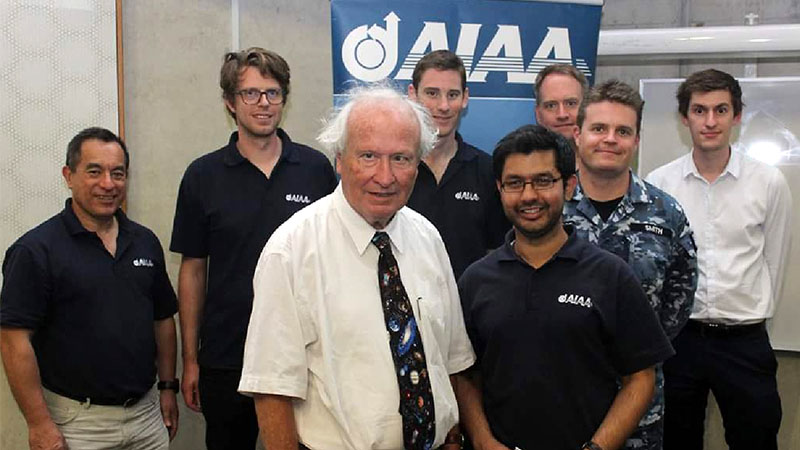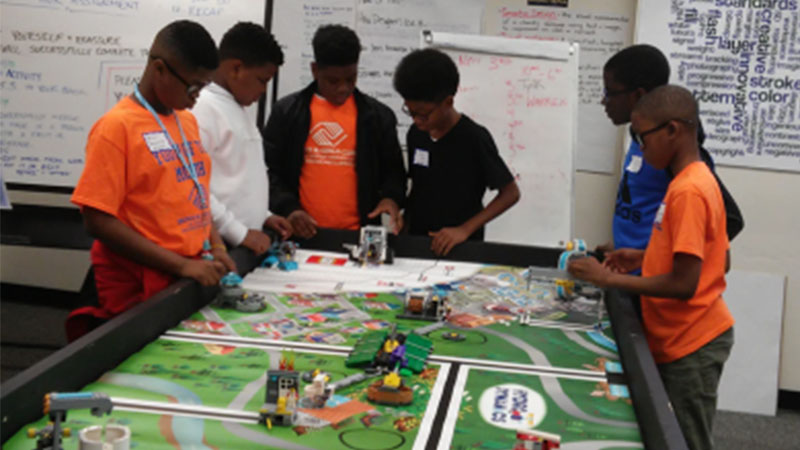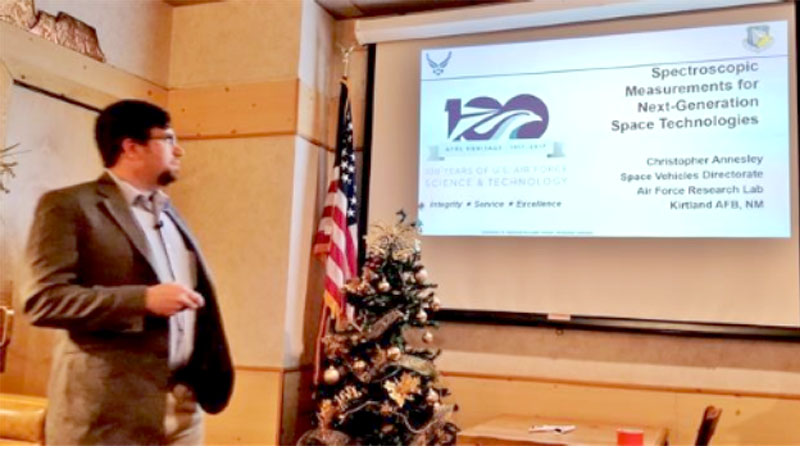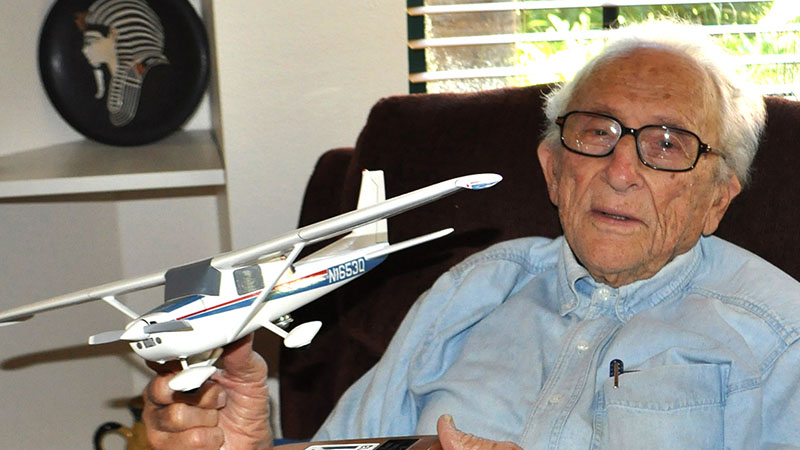- AIAA Sydney Section Commemorates 50th Anniversary of WRESAT1
- AIAA Diversity Scholars at AIAA SciTech Forum
- Reddy Honored With National Design Award
- Preparing the Next-Generation Diverse Technology Workforce
- Spectroscopic Measurements for Next-Generation Space Technologies
- ASAT 2018 To Be Held In May
- AIAA Associate Fellow Marx Died in January
- AIAA Senior Member Jeude Died in January
- AIAA Senior Member Lineberry Died in January
Bulletin
Section News AIAA Sydney Section Commemorates 50th Anniversary of WRESAT1

By Gordon Pike and Michael Spencer
Scenario: A rocket launch tower stands erect in the remote central Australian location of Woomera. Red dust is blown by the hot desert wind across the site, coating everything it touches. The rocket engineers at the site make the characteristic “Great Australian Salute” to wave away the black flies droning around their perspiring suntanned faces.
U.S. Member: “Hey Aussie! The SPARTA program has now concluded leaving us with one unused Redstone as a spare. If you had it, could you use it?”
Aussie Member: “Gidday, Mate! You bewdy. Streuth, absolutely, we could.”
This might have been a conversation between the Australian and American scientists and engineers 50 years ago in 1967 to initiate another of the many shared journeys in the history of Australian-U.S. partnered space activities except that this would result in the very first Australian-built satellite being successfully launched into space from an Australia launch site later in that same year.
On 29 November 2017, Australia commemorated the 50th anniversary of WRESAT1 (Weapons Research Establishment Satellite1), the first Australian-built satellite launched from an Australian launch site atop a U.S. Redstone rocket. The AIAA Sydney Section helped to commemorate this achievement, and revisit Australia’s space history, by hosting Dr. Gordon Pike, AIAA Associate Fellow, to give a lecture on “WRESAT1 – the Program and the People.” Dr. Pike is a prominent Australian space engineer who began his career at the Weapons Research Establishment (known today as the Australian Government’s Defence Science Technology Group) and had experiences working with the members of the original WRESAT1 project team.
During the late 1960s, the United States, United Kingdom, and Australia formed a research partnership to conduct the SPecial Antimissile Research Tests, Australia (SPARTA) Program2 at the Woomera Rocket Range to study the atmospheric re-entry phenomena and their effects on re-entering payloads based on a program of ten Redstone rocket launches. When the SPARTA program ended after nine launch events, the United States offered the spare tenth rocket to Australian scientists, on the condition that it had to be used before the U.S.-mandated return date for uplifting and returning all U.S.-owned SPARTA assets from Woomera.
This offer triggered an 11-month critical path project schedule for the Physics Department at the University of Adelaide to conceptualize, design, develop, test and be space-ready with a science mission for WRESAT1. WRE managed the project to mobilize and integrate the WRESAT1 payload to the Redstone rocket at the Woomera launch site. On 29 November 1967, WRESAT1 was launched and Australia had entered the orbital space environment. WRESAT1 successfully completed 642 orbits, and transmitted for 73 of these to tracking and research stations located around the world, before re-entering the Earth’s atmosphere on 10 January 1968 over the Atlantic Ocean.3
While WRESAT1 was the first Australian satellite to enter the Earth orbital environment, the first satellite built by Australians is credited to the amateur radio team who built Australis – Orbiting Satellite Carrying Amateur Radio-5 (OSCAR-5).4 Built in 1966 on a shoestring budget by an innovative project team of students and amateur radio enthusiasts studying at the University of Melbourne,5 it was offered a launch opportunity by the United States on a space launch from Vandenberg Air Force Base Space Launch Complex on 23 January 1970.
The OSCAR-5 university student project team was inspired by the rising popularity of the new science and technology of space communications and promoted in activities led by U.S.-based amateur radio operators. In 1969, the U.S. amateur radio operators established the Radio Amateur Satellite Corporation (today, known as AMSAT). OSCAR-5 was the fifth amateur-built satellite under the AMSAT satellite program, the first one built outside of the United States, and the first to be designed for remote control operations by amateur radio operators on the ground.
It is this spirit of innovation and “daring-do,” that inspired Australia’s early space engineering pioneers to “have a go,” supported by opportunities made available by U.S. counterparts. It is with this proud history that the AIAA Sydney Section, chartered in 1998 as the first AIAA section to be situated outside of the United States, keenly supports its members and engages with the public to promote and advance interests in aeronautics and astronautics. The continuing cooperation provided by the United States helps promote the importance of the enduring partnerships in many aviation- and space-related fields of industry, research, and academia.
The AIAA Sydney Section wanted to publicly commemorate the 50th anniversary of the WRESAT1 mission to highlight the space industry’s rightful place in Australian history and bring public recognition to some of the key people involved in the project. Many of the key members of the original WRESAT1 project team are no longer with us, but their family members were invited as special guests and were presented with special commemorative certificates prepared by the AIAA Sydney Section Committee.
Our event speaker, Dr. Pike, is a long-time, prominent figure in Australian space industry, history, and academia. He started his working life at the WRE, alongside members of the original WRESAT1 project team and then built an extensive career as a distinguished Australian scientist and space engineer. He has been directly involved throughout the entire history of Australia’s national communications satellite programs, space launch events, and National Broadband Network initiative. The AIAA Sydney Section members, special guests, and public audience were very appreciative of his lecture on the history of the WRESAT1, which entertained the audience with a good balance between technical descriptions of WRESAT1 and his personal experiences in very human encounters with WRESAT1 team members.
Reflecting on Australia’s space history also provided an opportunity to review Australia’s continuing role in its many diverse partnerships with the United States in space activities. Australia has been an integral part of U.S. deep-space missions dating back to 1957, when NASA started building its first Australian-based spacecraft tracking and communications facilities at Woomera. Today, the NASA Canberra Deep Space Communications Centre at Tidbinbilla continues to operate 24/7 to maintain vital communications for U.S. deep-space missions; cubesat technology has enabled Australian universities to access space missions; U.S. space launch opportunities have enabled Australian access to the orbital environment; cubesat missions have also been inserted into orbit from the International Space Station; and U.S. Air Force space situational awareness sensors sited in Australia enable Australian operators to contribute to the U.S. Space Surveillance Network. There is much to inspire the current and future generations to be involved in aerospace and space, and the AIAA Sydney Section is fortunate to have access to this global space community through AIAA to share these experiences and knowledge with Australian aeronauts, aerospace engineers and, maybe, a future Australian-flagged astronaut.
The opinions expressed are those of the authors and do not reflect the views of Optus, AMSAT, the Royal Australian Air Force, Defence Science Technology Group, or any other organization mentioned in this article.
NOTES:
1. DST Group (2017). WRESAT — Weapons Research Establishment Satellite. Online at www.dst.defence.gov.au/innovation/wresat-%E2%80%94-weapons-research-establishment-satellite
2. Dougherty, K (2017). WRESAT – Australia’s First Satellite. Online at
3. DST Group (2017). 50th anniversary of Australia’s first satellite. Online at www.dst.defence.gov.au/news/2017/11/08/50th-anniversary-australias-first-satellite
4. Australis OSCAR 5. Online at https://australis-oscar5.weebly.com.
5. Williamson, B (2017). Stargazing: How Aussie uni students convinced NASA to launch the first amateur radio satellite. Online at www.abc.net.au/news/2017-04-06/how-uni-students-got-nasa-to-launch-australias-first-satellite/8421480
Dr. Gordon Pike retired from Optus in late 2009 following a distinguished 38-year career in the Australian aerospace industry that began at the Weapons Research Establishment. He has had project management responsibilities for seven of the ten Australian communications satellites built and launched since 1985. He was the deputy program manager for the other three. He then became a part-time consultant to National Broadband Network Company for the satellite component of the National Broadband Network. Dr Pike was been recognized with numerous professional awards for his tireless efforts in promoting awareness of the benefits of space in the wider Australian community and for his long service in developing Australia’s satellite communications systems. He is an AIAA Associate Fellow.
Squadron Leader Michael Spencer is currently serving at the Royal Australian Air Force Air Power Development Centre in Canberra, analysing potential risks and opportunities posed by technology change drivers and disruptions to future air power. His Air Force career has provided operational experiences and qualifications in long-range maritime patrol, aircrew training, and weaponeering, and management experiences in international relations, project management, air and space concept development, air capability development, and joint force capability integration. He is an Associate Fellow and Section Committee member of the AIAA Sydney Section.
AIAA Program AIAA Diversity Scholars at AIAA SciTech Forum

The AIAA Diversity Working Group is pleased to announce that the inaugural class of AIAA Diversity Scholars attended the 2018 AIAA SciTech Forum. The AIAA Diversity Scholarship aims to directly combat underrepresentation in the industry by providing students from underrepresented groups the opportunity to attend AIAA forums, and receive additional targeted programming that may help them succeed in the aerospace industry.
This program was organized by AIAA volunteer, Therese Jones, and funding was received from Secure World Foundation, Florida Space Grant, Pennsylvania Space Grant and the Texas Space Grant so that 17 students could attend the AIAA SciTech Forum. Because of the success of this program, Airbus is sponsoring this scholarship at the AIAA AVIATION Forum in June. The scholarship welcomes applications from students in all disciplines with an interest in aerospace, including but not limited to STEM fields, communications, law, industrial design, journalism, and political science. Applications will open this spring. Students will be selected based on basic demographic information and a short essay describing their interest and experience in aviation.
“With the connections I made at this conference, I was able to land two interviews with companies that I would love to work for. I am exuberant to have the possibility to land a job thanks to this scholarship.” — Cody Keenan
“This forum showed me that the professionals currently in the space industry are open to discussing their roles and sharing their knowledge in an open, friendly, and relatable way. It has given me the confidence to better understand my place within this industry and showed me that the people in this industry are warm, welcoming, and willing to share their expertise.” — Chelsea Atkins
“Getting to know the other scholars so early on was definitely one of the highlights of the conference for me because I realized I was surrounded by so many like-minded people who share the same passion for space as I do.” “I hope to tell the story one day of how this conference and the grant I received started it all for me.” — Naia Butler-Craig
Member News Reddy Honored With National Design Award
AIAA Associate Fellow Dr. G. Satheesh Reddy, Scientific Adviser to Raksha Mantri and Director General, Missiles and Strategic Systems, has been recognized with the prestigious National Design Award for his significant national contributions toward indigenous design and development of diversified missile systems, guided weapons, avionics technologies and for his sustained efforts leading to the advancement of aerospace technologies and industries in India. Dr. Satheesh spearheads Dr APJ Abdul Kalam Missile Complex, “the missiles hub of India,” steering the design and development of wide variety of tactical and strategic missile systems. His contributions have left a lasting imprint on the technology map as well as on the defense preparedness of the country and paved the way for self-sufficiency in missile systems and technologies. Dr. Satheesh has played a major role in indigenous design and development of state-of-the-art weapon systems, formulation of national policies, harnessing the research and innovation in industry, academia, and R&D institutes. He received the award during the Indian Engineering Congress in December.
AIAA Foundation Preparing the Next-Generation Diverse Technology Workforce

Dr. Supriya Banerjee, FAMES and AIAA K-12 STEM Diversity Working Group Leader
FAMES® is dedicated to mentoring and educating underserved youth in Grades 4-12 in finance, arts, and STEM subjects through after-school and summer programing. The organization’s primary educational partnership is with the Boys & Girls Clubs of Greater Washington (BGCGW). As part of the 2017–2018 STEM after-school program, FAMES is engaging BGCGW students in the FIRST LEGO League (FLL) challenge. FAMES volunteers coach and mentor students in coding and robotic design, building team spirit to solve real-world problems and bolstering leadership skills. The program strives to inspire curiosity and introduce students to new career paths.
The students attested: “…I like the Lego League because I feel it will further my education,” and “…I want to learn more about Lego robotics and robotics in general.” Parents and grandparents are also excited about the students’ interest in our program: “My son became very interested in robotics from being part of your program.” The BGCGW Branch Director thanked FAMES for coaching and mentoring the students and taking them to the FLL tournament, an experience that helped encourage peer-to-peer learning as well. The students are eager to continue with the FAMES FLL program throughout the rest of the school year.
FAMES is focused on preparing the next-generation workforce by reaching into traditionally under-represented communities to introduce and engage them in STEM fields. Next school year, the program plans to expand by partnering with more youth clubs and schools near military installations to support the children of military families. A very special thanks to the AIAA Foundation for getting FAMES started in FLL. Additionally, FAMES would like to recognize the contributions from the major sponsors: The Boeing Company (sponsor of the AIAA Foundation FIRST LEGO League Grant Program), Leidos, SSAI, ERT, ADNET Systems, and Acima.
FAMES needs both financial and volunteer support from companies and individuals who are interested in nurturing and sustaining the students’ interest in STEM. Please consider joining us in our mission to grow the diverse STEM workforce of the future! Contact us at www.famesusa.org or info@famesusa.org.
Section News Spectroscopic Measurements for Next-Generation Space Technologies

By Ben Urioste, AIAA Albuquerque Section Communications Officer
Dr. Christopher Annesley of Air Force Research Laboratory RV gave a presentation at the December AIAA Albuquerque Section meeting. His work involves the study of the fundamental chemical dynamics of thruster plume species. The LaSR (Laser Spectroscopy and Reactivity) Lab studies plume species spectroscopically to better understand chemical transformations that occur in the space environment.
In one project they are studying VUV-induced UV fluorescence of chemical thruster plume species. To date, they have examined water photo-dissociation by 121.6 nm radiation to determine the rovibrational population distribution of OH(A) product. The other major project in the lab is studying ionic liquids that are being adopted as propellants in satellite thrusters. Specially, our research program utilizes gas-phase spectroscopy and mass spectrometry to explore the fundamental optical and structural properties of ionic liquid neutral pairs and ionic clusters. Using infrared spectroscopy, they have made several findings concerning the ion pair [EMIM][TF2N].
They are now expanding the studies to larger, charged clusters and made experimental threshold collision-induced dissociation (CID) measurements of charged clusters, where they have identified dissociation pathways. They have also undertaken a theoretical investigation on the hypergolic reaction of dicyanamide-based IL clusters with nitric acid. The section thanks Dr. Annesley for sharing his exciting work.
Section News ASAT 2018 To Be Held In May
By Dr. Amir S. Gohardani, Chair, AIAA Orange County Section
The 15th annual AIAA Southern California Aerospace Systems and Technology (ASAT) Conference and Banquet mark the premier event of the AIAA Orange County Section and will be held on Saturday, 12 May 2018. ASAT 2018 brings together Southern California researchers, leaders, students, educators, engineers, and enthusiasts for a program consisting of parallel tracks in both morning and afternoon session. ASAT 2018 accepts unclassified presentation on all aspects of aerospace systems, technology, vehicle design, program management, policy, economics, and education and will be structured the following three categories:
• Aircraft Systems and Technology
• Space Systems and Technology
• Aerospace Public Policy and Education
Students are strongly encouraged to present an outline of their senior thesis or graduate work. The ASAT conferences are carefully planned to provide a forum for exchanging new ideas, review achievements, and enable unique networking opportunities for future aerospace endeavors. These conferences bring together the aerospace sector of Southern California with the hopes of revitalizing the rich history of leadership and innovation in the area. Dino Roman and John Rose are ASAT 2018 Conference Chairs.
For the fourth year, the Gohardani Presentation Award in Aeronautics and Aerospace (sponsored by the Springs of Dreams Corporation) will also be presented to two of the most thought-provoking and exceptional all-around presentations delivered during the ASAT conference. The award is presented in a Junior Category and a Senior Category, based on experience and expertise in aeronautics and aerospace.
The deadline for submission of an Intent-to-Present is 30 March 2018. Notification of acceptance will be sent by 6 April 2018, and a final copy of the presentation will be due by 4 May 2018. For additional information, please visit the AIAA Orange County website: https://info.aiaa.org/Regions/Western/Orange_County or the event website: http://events.r20.constantcontact.com/register/event?oeidk=a07ee67lt0nf97db61d&llr=vitem6fab&showPage=true.
Obituary AIAA Associate Fellow Marx Died in January

Howard Marx died the first week of January. An emeritus member of AIAA with over 50 years of membership, he was an Associate Fellow, and was known as the “Grandfather of GPS.” He was 95 years old.
Marx attended Tulane University, earning a Bachelor’s degree in Mechanical Engineering, because Tulane did not have a program in Aeronautical Engineering. During World War II he served as a Lieutenant on the aircraft carrier, USS Franklin Roosevelt (CV-42). After the war, he completed his Master’s degree in Aerospace Engineering at MIT.
In 1963, after working at General Dynamics and LTV in Texas, Marx moved to the Aerospace Corporation to be a part of the space program. There he was tasked with developing a long-range plan for applying space technology to the problem of air navigation. This is when he decided that if there were a system of orbiting satellites transmitting signals continuously to provide position fixes for military aircraft, it would be a great advance in navigation. On 1 December 1964, Marx presented the study results and plans to management, followed by a similar presentation to the U.S. Air Force. GPS was declared operational 21 years later. Marx also worked on the F-5, YA-9, YF-17, and the F/A-18 aircraft programs at Northrop, retiring as a Vice President.
A member of the Institute of the Aeronautical Sciences (IAS) while at MIT, Marx remained committed to the Institute as it transitioned through the merger with the American Rocket Society (ARS) in 1963 and became AIAA. He was dedicated to various sectional, regional, and national positions later into his career and throughout his retirement, serving as the chairman of the AIAA Los Angeles Section, AIAA Region VI director, and on multiple technical committees (TC) including the History TC.
At the 2016 AIAA SciTech Forum, Howard Marx was memorialized as a young professional documented his life in a technical paper presented in the History Track (AIAA 2016-1894).
Obituary AIAA Senior Member Jeude Died in January
Edward A. Jeude died on 20 January. He was 90 years old.
Jeude attended a Naval Aviator training program, and Washington University (Saint Louis) where he received a B.S. in Mechanical Engineering. He worked numerous full-time jobs (Kisco Boiler, Anheuser Busch, and Presstite Engineering) while finishing college. His true career passion was aviation, and he joined the exciting era of Cold War jet fighter development, designing the Chance-Vought F-7U Cutlass and F-8U Crusader Navy fighter aircraft before finding his true home at McDonnell Aircraft, starting with the F-4H-1 Phantom program.
In 1963, Jeude transferred to Florida to work on Space Launch Operations for the Mercury and Gemini programs. Returning to Saint Louis in 1970, he enhanced a number of significant features on the F-15 Eagle, the Harrier AV8-B, and the F-18 Hornet (in a full circle moment, his younger grandson maintains F18s as a specialist in the U.S. Marines). Jeude continued to design and had 30 active clients in his private engineering business at the age of 90.




